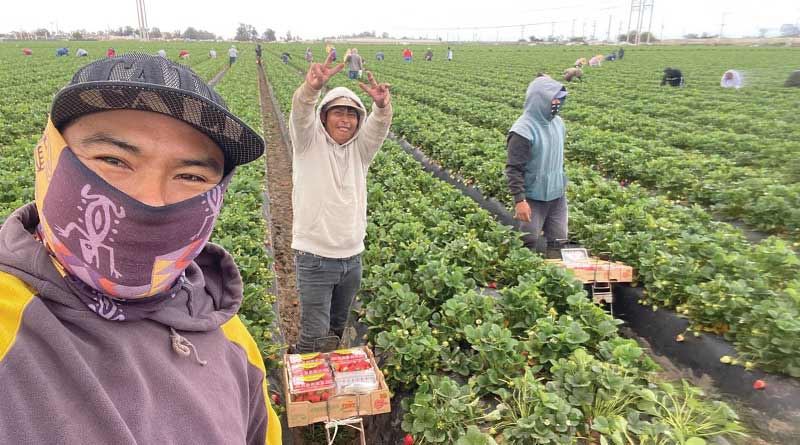Unions support new rules for protections from extreme heat
By Sheri Williams
With temperatures regularly topping three digits in California and across the nation, unions are applauding new state and national rules that will protect workers from the dangers of extreme heat.
However, unions also warn that the new protections at the national level are fragile and could be removed if Donald Trump is re-elected and fulfills his promise to gut government regulations.
In early July, the Biden administration proposed a first-of-its-kind regulation aimed at protecting workers from extreme heat, both indoors and outdoors.
Under the Biden proposal, there would be two triggers based on a heat index nationally. The first would apply when temperatures go above 80 degrees. Then, employers would be required to offer drinking water and rest breaks, as well as a plan for new workers to gradually increase their duties to better adjust to rising risks. The second heat index trigger would occur when temperatures top 90 degrees. Then, employers would be required to have mandatory 15-minute breaks every two hours and monitor for signs of heat illness in workers.
The plan would go into effect in 2026, but employers are already fighting it. Unions, however, have backed it with strong support.
“As we enter the second summer with temperatures reaching scorching record highs, the Biden administration’s new proposed rule could not be more urgently needed. Hot and humid conditions have long put indoor and outdoor workers at significant risk of heat-related illness and injury—with workers of color and immigrant workers facing disproportionate risks in many states. If finalized, this new rule would address some of the most basic needs for workers’ health and safety: water, shade, rest breaks, training and acclimatization for working in hot environments,” said AFL-CIO President Liz Shuler.
UFW President Teresa Romero, whose union has been on the front lines of fighting for heat protections for decades, said, “This is a bittersweet moment for farm workers. Every significant heat safety regulation in America at the state, and now federal, level was written in the blood of farm workers. Every year farm workers are killed by heat—with known deaths likely drastically outnumbered by the unknown, uncounted deaths. This is particularly true in states such as Florida and Texas, where extreme anti-worker and pro-death governors have taken extreme action to dismantle the few local workplace heat protections that existed.”
Romero continued, “Today, the federal government put itself on the right side of history by seeking, for the first time, to establish the precedent that every worker in America has the right to shade, water, and rest while working in temperatures that could kill them. As extreme temperatures continue to become the new normal, we also know it will continue to be America’s most marginalized yet essential workers, disproportionately immigrants, who will continue to be used by our society as disposable human shields against climate change. This proposal is a step towards becoming a better nation—one in which our economy is more resilient, our society more just, and every worker able to work with dignity and come home to their family.”
Service Employees International Union (SEIU) International President April Verrett, newly elected from California, also spoke about the new rules. Verrett pointed out that workers of color are most often those in jobs that face the risks of high heat.
“Today, the nearly two million members of the Service Employees International Union applaud the administration’s efforts to protect workers from increasingly dangerous levels of heat on the job. SEIU members across the country feel first-hand the effect of our warming planet, from the janitors and airplane cabin cleaners who often must work when the A/C is off, to the bus drivers, security guards, and other employees working outdoors or in hot vehicles without access to water or cooling breaks. Climate change is real and is already upon us, posing significant threats to people’s health and disproportionately affecting impoverished neighborhoods and communities of color,” Verrett said.
“Destiny Mervin, an Atlanta restaurant worker with the Union of Southern Service Workers, became an advocate for heat protections after her coworkers fainted on the job. Linda Ressler is a cabin cleaner at Phoenix Sky Harbor Airport and got involved after being told by managers that she and her coworkers were not allowed to bring water on planes, despite working in temperatures upwards of 100 degrees. President Biden’s new proposed rules on heat safety, along with his ongoing efforts to curb air pollution, show us that he’s listening to workers like Destiny and Linda and is ready to hold corporations accountable. We can’t afford to elect leaders who ignore climate change and aren’t concerned about our safety—especially someone who dismisses these jobs as ‘Black’ and ‘Hispanic’ jobs. Multiracial working-class voters will cast the deciding votes in this election, and this heat will not fade from our memory come November.”
Workers in California also applauded new state standards for indoorhigh-heat protection.
California’s Occupational Health and Safety (Cal/OSHA) Standards Board voted in July to finally pass protections for indoor workers after years of delay.
The new rules will cover workers who have jobs in places including warehouses, refineries and restaurants. In total, the state estimates the rules will cover about 1.4 million workers.
The regulations require employers to offer breaks, water and cool areas when temperatures go above 82 degrees. When temperatures go above that, reaching 87 degrees, the regulations require more frequent breaks, cooling devices and schedule changes including slowing down the pace of work.
